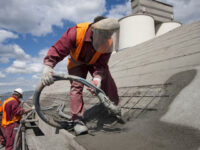Radiant Barrier Restoration
 Radiant barriers are typically installed in new homes before the roof sheathing goes on, but they can also be added to existing homes. This energy-efficient insulation consists of industrial-grade tin foil. It reflects radiant heat into the atmosphere rather than absorbing it. That allows your air conditioning system to keep your home comfortable without working as hard.
Radiant barriers are typically installed in new homes before the roof sheathing goes on, but they can also be added to existing homes. This energy-efficient insulation consists of industrial-grade tin foil. It reflects radiant heat into the atmosphere rather than absorbing it. That allows your air conditioning system to keep your home comfortable without working as hard.
When a radiant barrier is properly installed in your home, it will keep the sun’s heat off the roof and prevent it from being absorbed by the insulation and the rest of the attic. However, if the radiant barrier has holes or gaps, it will not be effective, and you will need to repair these areas as soon as possible. For more details, visit this website at https://www.ultimateradiantbarrier.com/.
The first step in performing radiant barrier repairs is to inspect the area for signs of damage, such as tears or punctures. If these are found, they must be promptly patched using foil tape or a specialized insulation sealant recommended by the manufacturer. You should also pay special attention to areas where the radiant barrier intersects with obstacles or penetrations, such as vents, chimneys, and electrical wiring in the attic. Cut the insulation boards where necessary to accommodate these, but leave sufficient space around them for proper airflow and function.
Once the gaps and holes have been patched, installing the new insulation board over the radiant barrier is time. It is important to use a thick insulation board that provides adequate R-value, or thermal resistance, to help ensure the radiant barrier remains effective for the life of the attic.
In addition, the old insulation should be swept clean to remove any dust or debris that may have accumulated over time. That will help prevent the deterioration of the attic insulation and further reduce the efficiency of the radiant barrier system.
Radiant barriers are an excellent solution for keeping your home cool in Texas summers, but you should hire a professional for installation to ensure the job is done correctly. The radiant barrier is a highly reflective material that deflects the solar rays before entering your attic and raises temperatures, reducing cooling costs. A professional can also assist with obtaining rebates for installing a radiant barrier. They will also be able to advise you on the best type of radiant barrier for your home and help you get the most from it.
When the radiant barrier is installed properly, it will reflect solar heat away from your home’s roof and ceilings. That will reduce the load on your air conditioning system and lower your energy costs. However, there are certain things that you must keep in mind when it comes to radiant barriers. That includes moisture issues, air leaks, dust accumulation, and compatibility with your existing insulation.
Moisture issues can significantly decrease the effectiveness of your radiant barrier. In addition, they can cause mold and mildew in your attic. They can also damage your attic’s structure and deteriorate the quality of your roof.
To avoid these problems, you should install the radiant barrier with the manufacturer’s instructions. That will help you achieve optimal performance and extend its lifespan. You should also regularly inspect your attic for signs of moisture. If you find any, you should address them immediately.
While it is possible to install a radiant barrier on your own, it’s best to leave the installation job to a professional. This way, you can rest assured that your radiant barrier is correctly installed and that there are no gaps or tears. In addition, a professional can also ensure that your insulation meets the required R-value for your climate.
A radiant barrier is an excellent option for reducing cooling costs in warm climates. It’s estimated to save homeowners up to $120 per year. However, a radiant barrier will provide different benefits in cold temperatures. That is because insulation offers better protection against heat loss.
Radiant barriers are typically installed in attics, primarily under the roof. They are made from a reflective foil that helps control radiation and keeps your attic cooler. That will help reduce cooling costs and may even allow you to reduce the size of your air conditioner.
The radiant barrier keeps homes cooler by reflecting the sun’s heat into the atmosphere. That keeps the attic cooler and allows the air conditioner to work less efficiently, saving energy. It also helps to extend the life of your air conditioning unit.
A radiant barrier of silver-backed foil is installed in the attic between the joists over the existing insulation. It prevents the sun’s rays from entering a loft and can reduce cooling costs by up to 10 percent.
When paired with normal insulation, radiant barriers can significantly cut energy bills. However, they do not offer a high R-value like traditional batt, roll, or blown-in insulation. They can help keep insulation in good condition, but they will only replace it partially if it is not damaged.
Radiant barriers must be installed properly to be effective. That requires sealing air leaks in the attic and addressing moisture issues before installing the foil. Air leaks are usually caused by poorly sealed attic hatches, lights and fixtures, fans, and doors. Moisture problems are caused by condensation and ventilation. If these issues are not addressed, they may lead to fungal growth and mold in the attic.
To ensure that the radiant barrier is working effectively, homeowners should regularly inspect the attic to ensure no holes or gaps. In addition, they should ensure that the foil isn’t covered with dust or debris. If it is, the homeowner should vacuum or sweep the attic to remove the dust.
Homeowners can improve the efficiency of their attic by replacing the old insulation with a new, higher R-value material. If they are experiencing high energy bills, they can also contact a local insulation and radiant barrier company for a full inspection. The professionals will examine the attic, insulation, and more to determine what is causing their high energy bills. They can then recommend solutions to keep the home more comfortable and efficient while reducing the homeowner’s reliance on air conditioning. That will save them money and help to improve the environment.
Radiant barriers reduce energy costs by preventing your attic from absorbing the sun’s heat and redirecting it toward the ceiling and walls of the home. They are particularly useful in warm climates and can save homeowners thousands of dollars in cooling costs over the roof’s lifetime. However, radiant barriers are only effective in an attic that is ventilated properly. It is important to have a certified professional perform regular insulation inspections and promptly address any issues that may arise.
If you choose to install a radiant barrier yourself, you will need the following tools:
The most common type of radiant barrier is aluminum foil laminated to one or more substrate materials. These materials can include kraft paper, plastic films, cardboard, oriented strand board, and air infiltration barrier material. Some radiant barrier products are fiber-reinforced for increased durability and ease of handling.
If you choose to use the stapling method of installation, you will need a good supply of staples. Safety equipment: Long-sleeved shirts, gloves, and safety goggles are recommended to protect your skin and eyes from potential irritation. Ladder: A sturdy ladder is necessary to access the attic where the radiant barrier will be installed.
Accurate measurements will ensure enough radiant barrier material covers the entire attic space. Cutting tool: A utility knife or scissors will cut the insulation boards to the appropriate size. Insulation sealants and foil tape: Sealants are needed to prevent any gaps or seams from allowing heat transfer.
Moisture problems are the biggest threat to radiant barrier effectiveness, and inspecting your attic for signs of moisture on a routine basis is important. That will help to identify and repair any leaks before they cause serious damage.






